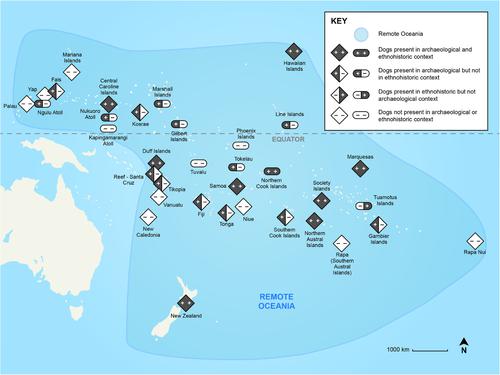当前位置:
X-MOL 学术
›
Archaeology in Oceania
›
论文详情
Our official English website, www.x-mol.net, welcomes your
feedback! (Note: you will need to create a separate account there.)
The Dogs of Remote Oceania: an archaeological and ethnohistorical view of domestic dog introduction and loss in the South Pacific
Archaeology in Oceania ( IF 1.1 ) Pub Date : 2021-09-14 , DOI: 10.1002/arco.5252 Justin Cramb 1
Archaeology in Oceania ( IF 1.1 ) Pub Date : 2021-09-14 , DOI: 10.1002/arco.5252 Justin Cramb 1
Affiliation

|
Domestic dogs were transported by voyagers to the islands of Remote Oceania. However, the distribution of these, and other domesticates, varies by location. By the time of European contact, dogs were extirpated from many islands, but the cause of their disappearance remains unknown. Archaeological reports and ethnohistoric text analysed for 35 islands and island groups in Remote Oceania reveal regional patterns of dog introduction and loss that shed light on their disappearance. The findings of this survey indicate that people introduced dogs to most island groups in Remote Oceania and that pre-European extirpation rates were high. The highest localized extinction rates occurred on low islands suggesting that low-island vulnerabilities and spatial constraints on population size affect survivorship. The dogs of Remote Oceania have a complex history in which introduction to new islands was common, but long-term persistence was difficult.
中文翻译:

偏远大洋洲的狗:南太平洋家犬引进和丧失的考古学和民族史观
航海者将家犬运送到偏远的大洋洲岛屿。然而,这些和其他驯化动物的分布因地点而异。到欧洲接触时,许多岛屿上的狗已经灭绝,但它们消失的原因仍然未知。对偏远大洋洲的 35 个岛屿和岛屿群进行的考古报告和民族历史文本分析揭示了狗的引入和消失的区域模式,这些模式揭示了它们的消失。这项调查的结果表明,人们向偏远大洋洲的大多数岛屿群体介绍了狗,并且欧洲前的灭绝率很高。最高的局部灭绝率发生在低岛,这表明低岛的脆弱性和对人口规模的空间限制会影响生存率。
更新日期:2021-09-14
中文翻译:

偏远大洋洲的狗:南太平洋家犬引进和丧失的考古学和民族史观
航海者将家犬运送到偏远的大洋洲岛屿。然而,这些和其他驯化动物的分布因地点而异。到欧洲接触时,许多岛屿上的狗已经灭绝,但它们消失的原因仍然未知。对偏远大洋洲的 35 个岛屿和岛屿群进行的考古报告和民族历史文本分析揭示了狗的引入和消失的区域模式,这些模式揭示了它们的消失。这项调查的结果表明,人们向偏远大洋洲的大多数岛屿群体介绍了狗,并且欧洲前的灭绝率很高。最高的局部灭绝率发生在低岛,这表明低岛的脆弱性和对人口规模的空间限制会影响生存率。











































 京公网安备 11010802027423号
京公网安备 11010802027423号